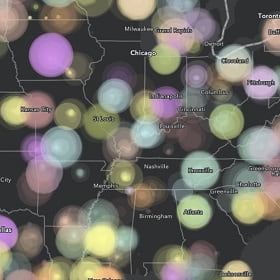Since WhereNext launched in 2017, we’ve interviewed successful, creative professionals in many business sectors. Some of them make a living analyzing location data to help colleagues achieve efficiency, sustainability, and competitive advantage. Others make high-impact business decisions after consulting smart maps and location analytics.
Their stories are inspirational, occasionally confessional, and filled with good advice. But not all of their insight makes it into our articles. Now, in the spirit of the season, we’ve gathered the best omissions for a behind-the-scenes look at what business executives and GIS analysts hope for in the year ahead—and what advice they have for one another.
Business Executives: Trust Your Analysts
GIS Analysts: Speak the Language of Executives
GIS technology has become indispensable to many businesses, informing multimillion-dollar real estate decisions, guiding safe office returns during the pandemic, and demystifying supply chains. At one Fortune 200 real estate company, the executive vice president—charged with introducing GIS to her organization—likened the technology to a Ferrari, but said she needed someone who could get across its value to business leaders. “You need a businessperson to lead this, to speak business speak,” she explained. “You need someone that’s not going to try to sell you on the mechanics of that Ferrari . . . [but instead] take you into the experience of owning that car. You have to win what we call ‘hearts and minds.'”
A new kind of GIS analyst is doing just that. These professionals are proficient in data wrangling, Python scripting, and smart maps—and they understand the mindset of a business leader. One GIS manager in the energy sector advanced her career by thinking like a CEO. “I found a common language with executives,” she told WhereNext. “Cost and safety—safety of our employees and the cost and the impact to the bottom line if we weren’t safe or if we weren’t efficient.”
The lead supply chain GIS analyst at one of the world’s most popular quick-service restaurants is comfortable presenting to executives, who regularly use his analyses to make strategic decisions. But that wasn’t the case earlier in his career, at a company where the relationship between data scientists and executives was almost adversarial. His advice to executives: “Trust your people. Organizations go to great efforts to hire people [with] analytics skills, but then often don’t let them have a voice. These could be great decision-makers within your organizations in the future. They have the technical skills. Often, they have a business understanding. Just ask them, ‘What would you do differently? What are the things we’re not seeing?’ And trust them and give them the space and the training to grow. It will really help your organization long term.”
One GIS analyst in the consumer packaged goods industry in Africa spent her early career developing the ability to convey the technology’s value. “I used to follow [my boss] around when he used to meet clients,” she said. “So I learned from how he was speaking when he [was] explaining how GIS can be inculcated into business.”
The director of emergency operations at a global company with hundreds of thousands of employees advises GIS analysts and data scientists to brace themselves once they earn executives’ trust. “Once you have that skill and people know that you have that skill, they’ll come to you for anything and everything,” he said. “So many times I’ve seen one of [our team members] standing at the command post with executive leadership over their shoulder saying, ‘Show me this. Show me that. Go here, go there.’ Being able to handle that pressure is incredibly important.”

Everything we do is couched in the business, and we have to use the language that our business understands and that our stakeholders understand.
Business Executives: Invest in Data
GIS Analysts: Dig Deeper into the Information
The CIO of a US-based energy company encourages GIS analysts to push data to its limits. “If you look at the concept of continuous improvement, you never sit and say you’re done. Because the more data you gather and the more information you have, the more it informs you about things you didn’t know . . . or directs you on how much of the data is useful and how much isn’t,” he explained. “There’s always room for more efficiency and more effectiveness and more understanding, and that’s just informed by more data.”
During the early days of the COVID-19 pandemic, the close-knit group of GIS analysts at a major hotel chain went looking for data on geographic areas where economic activity remained strong. With that information, hotel operators identified groups that needed lodging—hospital workers, interstate truckers—and kept the business healthy by serving them, according to the senior director of business analytics. Such data has become part of everyday business decisions.
“We’re [now] able to leverage a lot more data that’s not readily available within the company,” the director said. “Historically, a lot of our analysis would be based on transactional data that we have within the company or data that partners have provided to us. But in each of these cases, we had to go out and [for example] find a list of hospitals of a certain size. For the logistics routes, we had to find information which happened to be [from the] department of transportation—some subsite of a subsite of a subsite somewhere.”
The real estate EVP enjoys the moments when GIS analysts convert data to location intelligence and their colleagues finally see its worth. “What I hear is the aha moment of, ‘I didn’t know we had that data . . . I didn’t know that we could tell that story,'” she explained. “I hear that a lot, and I love it, because that means that we’re still discovering the power and unlocking the power.”
A CIO in the same industry notes that curating business data is often more difficult than executives suspect. Her advice to GIS analysts: “Partner, partner, partner with your business leaders” to educate them on the importance of data. “That will make it easier when you’re building a location intelligence tool,” she advised.
Location intelligence is a regular source of insight at one furniture manufacturer that’s shaking up a conventional industry with novel direct-to-consumer strategies. The company’s VP of product development told WhereNext that location data is a fixture of executive meetings. “When . . . we have a bad week or bad month, we know exactly why and where,” he said. That wasn’t the case at other companies he’d worked for, where sales managers were often baffled by sales fluctuations. “When we have our weekly business reviews, you do not want to come in there with your sales off and not have any idea how you’re going to get them back. Data helps you have that plan.”
Business Executives: Lift Up a New Kind of Intelligence
GIS Analysts: Connect with Business Colleagues
The phrase “a new intelligence” has surfaced in business conversations lately, as GIS analysts team up with data scientists and BI experts to add geographic perspective to data. Together, they’re assessing not just what is happening in a business, but also where, why, and how conditions can be improved.
To reap the benefits of this new intelligence across an organization, executives must be willing to pair GIS analysts with line-of-business managers to solve strategic challenges. In turn, GIS analysts must be ready to collaborate with new colleagues and stretch their vision for what can be accomplished with location technology.
At one of the best-known agricultural companies in the world, the GIS platform manager has become an agent of this new intelligence, and she credits management for fostering new connections. “Our forecasting director has really done well to acquaint me with the supply chain [team] as well as sales and operations planning projects,” she explained. “He’s taken a lot of time to listen and understand the base of what GIS can do and then further connect me with projects that can help represent the value that GIS brings to the business.”
Executives who haven’t yet understood the value of partnering GIS teams with line-of-business colleagues are missing a key opportunity, says the director of analytics at a well-known global bank. “You just need to unleash value using these tools and platform,” he told WhereNext, adding that once a company has applied analytics and location intelligence to one project, value tends to multiply. “We help to reduce the attrition rate. We help to make a better customer experience for our customers. We use it for more effective and efficient branch planning,” he said. “It’s beyond just the dots on the map.”
The president of a utility company in the southeastern US believes he’s found a reliable source of this new intelligence. “Whatever you do, get to the right people on the technology side,” he advised. “Don’t get to the salespeople; get to the tech people. Those are the people you want to talk to and those are the people who can help the most—who will break their back helping you. They’re the most creative people.”
The director of emergency operations at a global retailer agrees, and says that despite GIS technology’s reputation as a trusted resource for critical decision-making, it is underutilized in the Fortune 500. “I think that as you introduce a tool like this into the business, even though you may have brought it in in a crisis, then you can start expanding out beyond just real estate and understanding customers and . . . inefficiencies in supply chain—or even doing things like mapping . . . the supply chain for the manufacturing plants. Where do they manufacture? What’s the shipping time on the water? Where are potential interruptions or bottlenecks in our own supply chain? The use cases are unlimited. It just becomes a matter of, how do you get the tool into the hands of the right people and give them some education or exposure to new ways of doing business that will make them more efficient or effective?”
Business Executives: Take the Geographic Approach, Don’t Wait
GIS Analysts: Remember to Show Your Value
Once GIS analysts partner with business managers, embrace a new intelligence, and learn to speak the language of executives, they should continue pressing forward, says the energy industry GIS manager. “Any chance I get to talk to an executive or management, I say, ‘Let me show you this cool thing we did that the business has already been using for the last year. Can we continue using it, but in a different region?’ And then they say, ‘Well, that makes sense, if you’ve already implemented it.'”
In the hospitality industry, one GIS manager sees the broader adoption of location intelligence as inevitable. “As you get younger people who are more accustomed to technology in positions of leadership, then they are more likely to embrace what you are doing. As the old guard moves on and is replaced by a younger generation, then you’re more likely to see advances.”
For now, innovative companies are emphasizing partnerships between business decision-makers and location analysts that have begun to bear fruit.
“Really, it’s about trust both ways,” said the supply chain analyst at a popular quick-service restaurant chain. “As I developed my [GIS] brand within the organization, as the leaders were able to put trust in me and let me do the work that I was able to do, I think that’s where the most value comes in. Even now, it’s [about] trusting the analytics people to do their job really well and create value for the organization, and the analytics people [trusting] the leaders to listen to them and . . . their ideas.”











